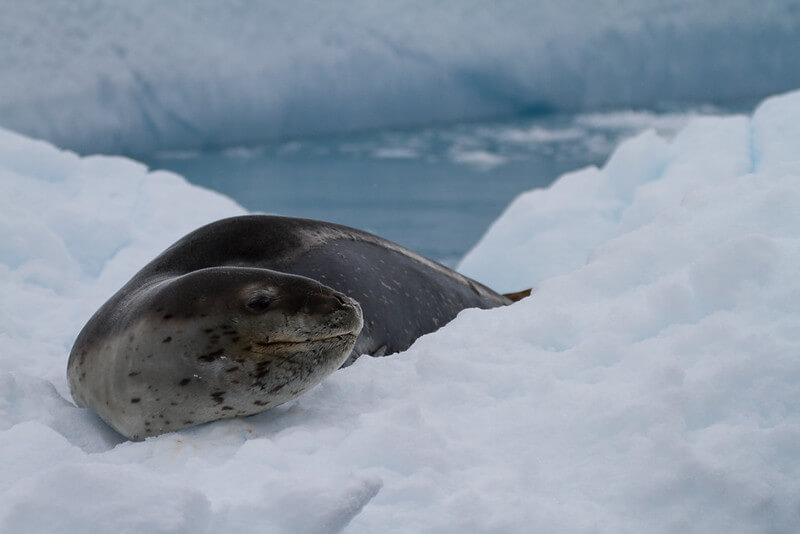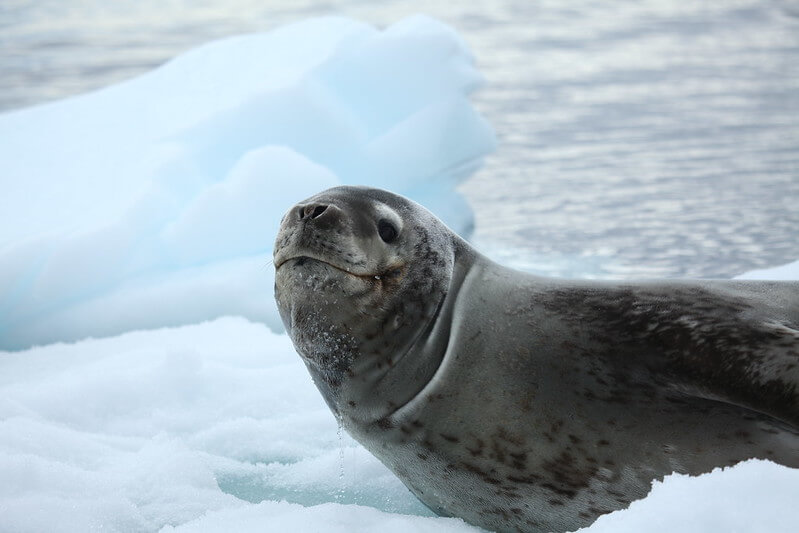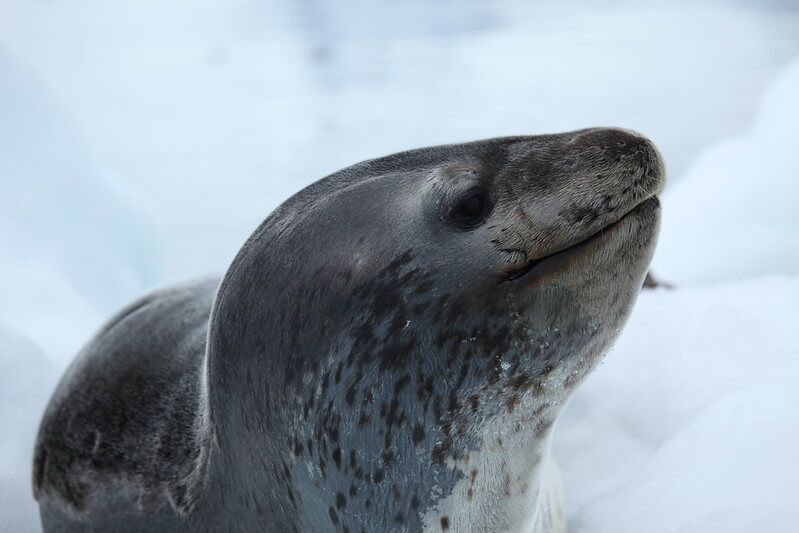The leopard seal is aptly named because of the spotted pattern on its body that resembles that of the large cat.
Another thing that this marine mammal shares with its namesake is the fact that the leopard seal is a highly efficient predator famously known for consuming penguins.
This large marine mammal is one of the top predators found in Antarctica and has a wide array of amazing adaptations and behaviors.
That’s why today I would like to share with you 10 interesting leopard seal facts that will be both, educational and slightly terrifying.
1. Leopard Seals Are HUGE
The leopard seal is the second-largest seal in the Antarctic and the third-largest seal species in the world.
This marine mammal displays a very obvious case of sexual dimorphism with the female being much larger than her male counterpart.
A male leopard seal can reach a weight of 300 kg / 361 lbs. and a length of 3.3 m / 11 ft.
The female, on the other hand, grows to a colossal length of 3.8 m / 12.4 ft. and can easily weigh 500 kg / 1,100 lbs. with some reaching the impressive weight of 590 kg / 1,300 lbs.
2. Leopard Seals Only Have 1 Predator
The leopard seal is an apex predator on land as there is not a single animal out there that can hunt it down.
However, once in the water, this marine mammal must be on the lookout for killer whales as these are the only known predators of the leopard seal.
3. Leopard Seals Are Long-Lived
Due to the fact that the leopard seal only has one predator its chances of dying of old age are pretty high.
If this seal manages to evade killer whale attacks during its lifetime it can easily live to be more than 30 years old.

However, the average lifespan for a leopard seal is 23 years for a male and 26 for a female.
4. Leopard Seals Are Solitary
Aside from breeding periods and nursing mothers, the leopard seal is a solitary animal.
This marine mammal doesn’t engage in cooperative hunting and tends to be aggressive toward conspecifics when around food.
In fact, for a long time, scientists thought that the leopard seal was indeed occasionally engaging in cooperative hunting and upon closer inspection, it was discovered that these animals were actually stealing prey from each other.
There have been some very rare sightings of small congregations of 2 – 3 leopard seals hunting together.
There’s not a lot of information available as to why this would happen as studying this species in the wild is quite difficult because of the remote and hostile place it inhabits.
5. Leopard Seals Are The Only Seal To Eat Warm-Blooded Prey
All seal species have a diet made up of fish, crustaceans, and cephalopods.
The leopard seal is famous for regularly feeding on penguins but it will even kill and devour other seal species.
Pups and juveniles of the crabeater, Weddell, Ross, Antarctic fur, and southern elephant seals are a preferred menu item for the leopard seal.
6. Leopard Seals Have Unique Teeth
Despite being a highly efficient predator of a wide variety of animals the leopard seal also consumes a significant amount of tiny krill.
This mammal has special cheek teeth that are shaped in such a way that they lock together working as a strainer that filters out sea water while leaving the krill inside the mouth of the leopard seal.
7. Leopard Seals Enjoy Bullying Animals
It has been widely observed by scientists that a leopard seal will engage in predator-prey chases with terrified animals, such as penguins, for the mere reason of enjoyment.
This conclusion was reached after multiple observations of this behavior performed by seals who had already eaten more than enough for the day and who would eventually just get bored and let the poor terrified creature return to safety unharmed.
8. Leopard Seals Are Fast Swimmers
The leopard seal has a streamlined body with strong flippers that allow it to reach a swimming speed of 40 km / 25 miles per hour.

This is not only useful for chasing prey but it’s actually fast enough for the seal to be able to propel itself out of the water and onto the ice if it’s being chased by an orca.
9. Leopard Seals Can Kill You
Due to the limited, and inhospitable, range the leopard seal inhabits chances are you don’t need to worry about running into one during your next family holiday.
However, it is important to remember that it is an extremely strong and aggressive predator and caution must be exercised.
In 2003 a marine biologist died from drowning after a leopard seal grabbed her and pulled her 60 m / 197 ft. underwater.
It’s unclear whether the leopard seal wanted to kill the woman or not.
10. A Leopard Seal Tried To Feed A Person
I want to end this list on a positive note and tell you a heartwarming story that involves a female leopard seal and world-renowned wildlife photographer Paul Nicken.
Paul visited the Antarctic in 2006 because he wanted to spend several days photographing leopard seals in their natural habitat.
Almost immediately he was approached by a large adult female who displayed some aggression and territoriality.
In an unexpected turn of events, as the days went by the female seemed to start viewing Paul as a weaker animal who needed some help and started trying to feed him.
At first, the seal would bring Paul penguins, that were still alive, and throw them in his direction.
As this approach wasn’t working she sharted bringing injured penguins; this eventually escalated to dead penguins and eventually a very annoyed seal placed a dead penguin right on top of the photographer’s head as, in her eyes, he was obviously not understanding the assignment.
This went on for several days as the comforting female tried to feed this strange animal that couldn’t fend for himself and the pictures of that expedition have gone on to become the most famous in leopard seal history.
I am a lover of everything nature and animal related with over 15 years of experience in the field of wildlife rescue and education. Currently living in Colombia working with wild and domestic animals and spending all my free time writing about them 🙂

